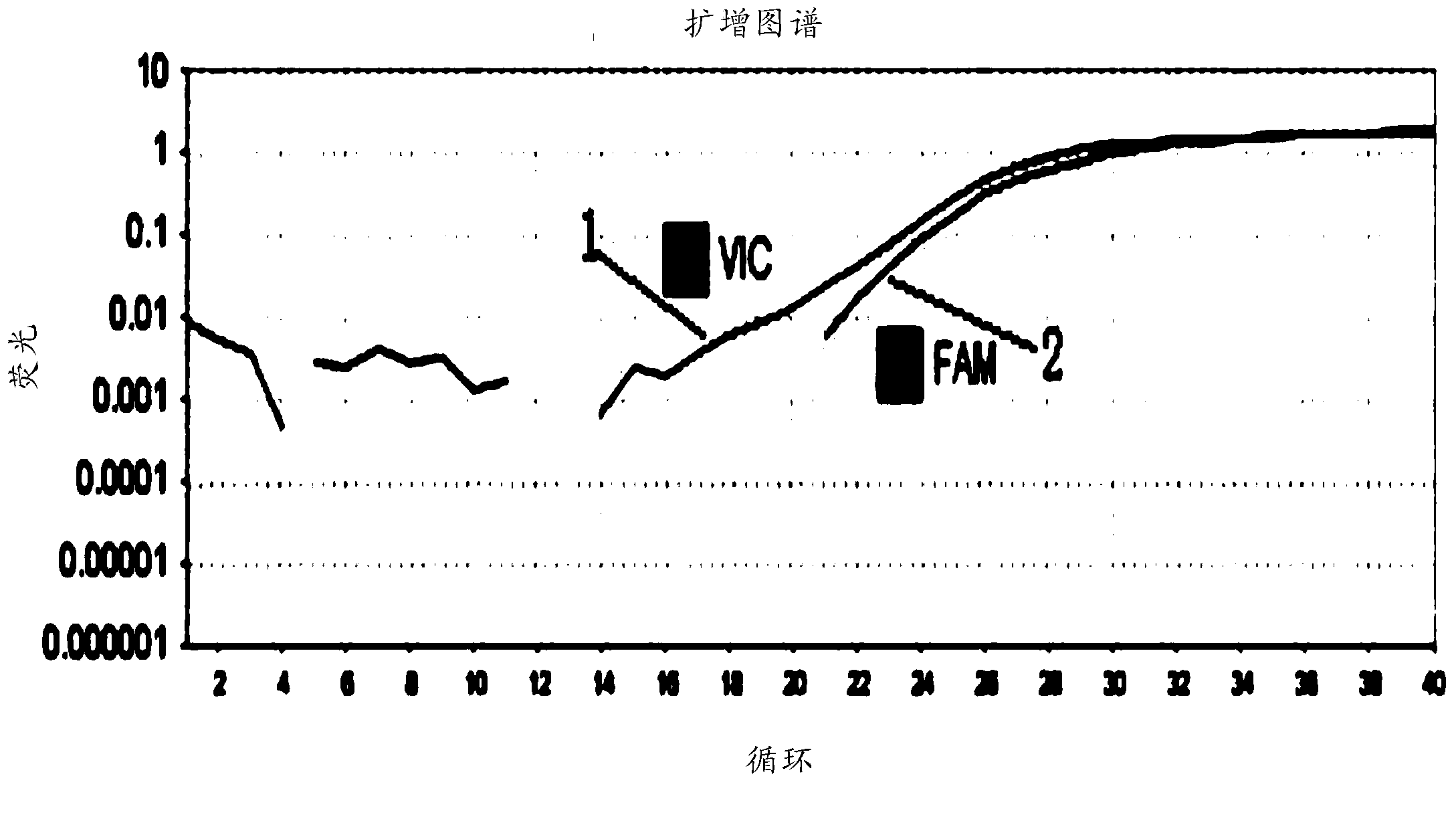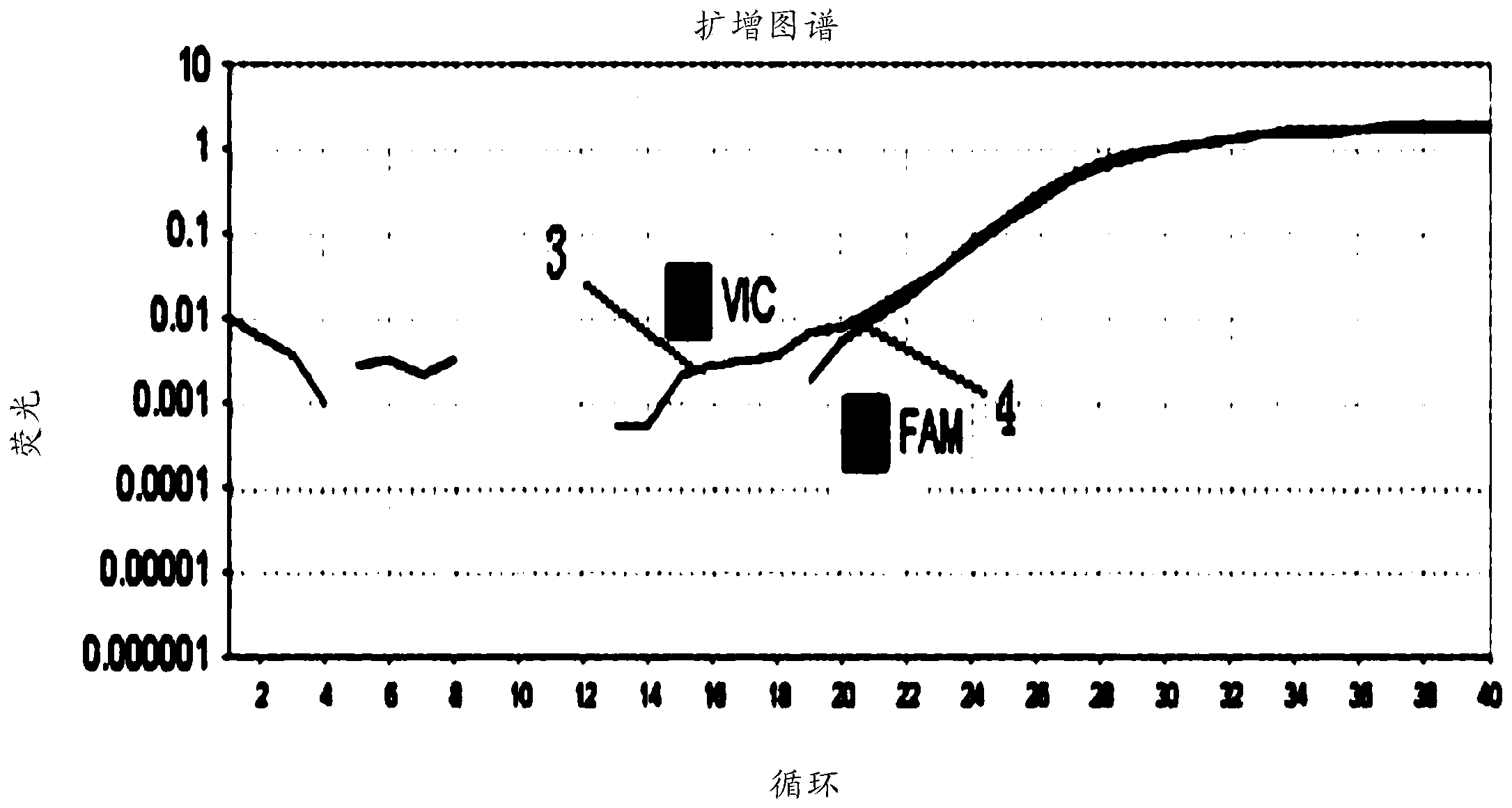Detection method of genes in chromosome 21, correlated detection probe combination, detection kit and correlated application
A gene detection and chromosome technology, applied in biochemical equipment and methods, recombinant DNA technology, microbial measurement/inspection, etc., can solve the problems of long detection time, high sample requirements, poor quality of life of patients, etc., to achieve ingenious design, Avoid sample contamination and detect rapid results
- Summary
- Abstract
- Description
- Claims
- Application Information
AI Technical Summary
Problems solved by technology
Method used
Image
Examples
Embodiment 1
[0023] Example 1: DNA preparation
[0024] 1) Preparation of normal human genomic DNA for testing
[0025] Take normal human blood filter paper, extract and prepare by Chlex100, and adjust the concentration of normal human genomic DNA to 10ng / μl. 2) Normal genotype standard preparation
[0026] Based on human chromosome 21 ADAMTS5 (a disintegrin and metallopeptidase with thrombospondin type1motif5) gene, DSCRA (Down syndrome critical region gene3, Down syndrome key Regional gene 3) gene and internal reference gene β-actin sequence, artificially synthesized ADAMTS5 (SEQ ID NO:1), DSCRA (SEQ ID NO:2) and β-actin (SEQ ID NO:3). The T vectors containing the above fragments were mixed at a ratio of 1:1:1, and the concentration was adjusted to 1ng / ul as a 10-fold normal genotype template.
[0027] 3) Preparation of 21 Chromosomal Abnormal Genotype Standards
[0028] Synthetic ADAMTS5 (SEQ ID NO:1), DSCRA (SEQ ID NO:2) and β-actin (SEQ ID NO:3). The T vectors containing the abov...
Embodiment 2
[0029]Example 2: Design and synthesis of chromosome 21-specific single-copy gene amplification primers and MGB probes
[0030] Synthetic primers were designed according to human chromosome 21 ADAMTS5 and DSCRA, the ADAMTS5 gene and DSCRA gene probes were labeled with Fam, and the internal reference gene probe was labeled with Vic. Verify that fluorescent quantitative PCR primers specifically amplify target gene fragments, and Taqman MGB site-specific probes report corresponding fluorescent signals. Artificially synthesized gene fragment-specific amplification primers and site-specific Taqman MGB reporter probes. See Table 1 and Table 2 for gene fragment-specific primers and site-specific Taqman MGB probe sequences (SEQ ID NO: 4 to SEQ ID NO: 12).
[0031] Table 1
[0032]
[0033] Table 2
[0034]
Embodiment 3
[0035] Example 3: Quantitative PCR detection of 21 chromosome-specific single-copy genes
[0036] 1) ADAMTS5 gene verification
[0037] Reaction system: 2.5 μl of primer-probe mixture, 12.5 μl of 2-fold Multiplex PCR Mix (QIAGEN N.V., Germany), 2.5 μl of standard template, 5 μl of 5-fold Easy Buffer, ddH 2 O2.5 μl.
[0038] Quantitative PCR instrument: ABI7500 (Life Technologies, USA).
[0039] Reaction conditions: 95°C for 5 minutes; 94°C for 30 seconds—60°C for 30 seconds—72°C for 45 seconds, 40 cycles.
[0040] 2) DSCRA genetic verification
[0041] Reaction system: 2.5 μl of primer-probe mixture, 12.5 μl of 2-fold Multiplex PCR Mix (QIAGEN N.V., Germany), 2.5 μl of standard template, 5 μl of 5-fold Easy Buffer, ddH 2 O2.5 μl.
[0042] Quantitative PCR instrument: ABI7500 (Life Technologies, USA).
[0043] Reaction conditions: 95°C for 5 minutes; 94°C for 30 seconds—60°C for 30 seconds—72°C for 45 seconds, 40 cycles.
PUM
 Login to View More
Login to View More Abstract
Description
Claims
Application Information
 Login to View More
Login to View More - R&D
- Intellectual Property
- Life Sciences
- Materials
- Tech Scout
- Unparalleled Data Quality
- Higher Quality Content
- 60% Fewer Hallucinations
Browse by: Latest US Patents, China's latest patents, Technical Efficacy Thesaurus, Application Domain, Technology Topic, Popular Technical Reports.
© 2025 PatSnap. All rights reserved.Legal|Privacy policy|Modern Slavery Act Transparency Statement|Sitemap|About US| Contact US: help@patsnap.com



